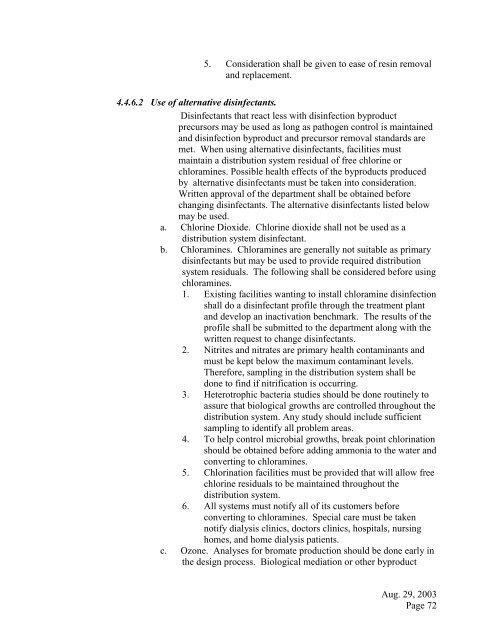Design Guide for Community Water Systems - The Water, Sanitation ...
Design Guide for Community Water Systems - The Water, Sanitation ...
Design Guide for Community Water Systems - The Water, Sanitation ...
Create successful ePaper yourself
Turn your PDF publications into a flip-book with our unique Google optimized e-Paper software.
5. Consideration shall be given to ease of resin removaland replacement.4.4.6.2 Use of alternative disinfectants.Disinfectants that react less with disinfection byproductprecursors may be used as long as pathogen control is maintainedand disinfection byproduct and precursor removal standards aremet. When using alternative disinfectants, facilities mustmaintain a distribution system residual of free chlorine orchloramines. Possible health effects of the byproducts producedby alternative disinfectants must be taken into consideration.Written approval of the department shall be obtained be<strong>for</strong>echanging disinfectants. <strong>The</strong> alternative disinfectants listed belowmay be used.a. Chlorine Dioxide. Chlorine dioxide shall not be used as adistribution system disinfectant.b. Chloramines. Chloramines are generally not suitable as primarydisinfectants but may be used to provide required distributionsystem residuals. <strong>The</strong> following shall be considered be<strong>for</strong>e usingchloramines.1. Existing facilities wanting to install chloramine disinfectionshall do a disinfectant profile through the treatment plantand develop an inactivation benchmark. <strong>The</strong> results of theprofile shall be submitted to the department along with thewritten request to change disinfectants.2. Nitrites and nitrates are primary health contaminants andmust be kept below the maximum contaminant levels.<strong>The</strong>re<strong>for</strong>e, sampling in the distribution system shall bedone to find if nitrification is occurring.3. Heterotrophic bacteria studies should be done routinely toassure that biological growths are controlled throughout thedistribution system. Any study should include sufficientsampling to identify all problem areas.4. To help control microbial growths, break point chlorinationshould be obtained be<strong>for</strong>e adding ammonia to the water andconverting to chloramines.5. Chlorination facilities must be provided that will allow freechlorine residuals to be maintained throughout thedistribution system.6. All systems must notify all of its customers be<strong>for</strong>econverting to chloramines. Special care must be takennotify dialysis clinics, doctors clinics, hospitals, nursinghomes, and home dialysis patients.c. Ozone. Analyses <strong>for</strong> bromate production should be done early inthe design process. Biological mediation or other byproductAug. 29, 2003Page 72
















